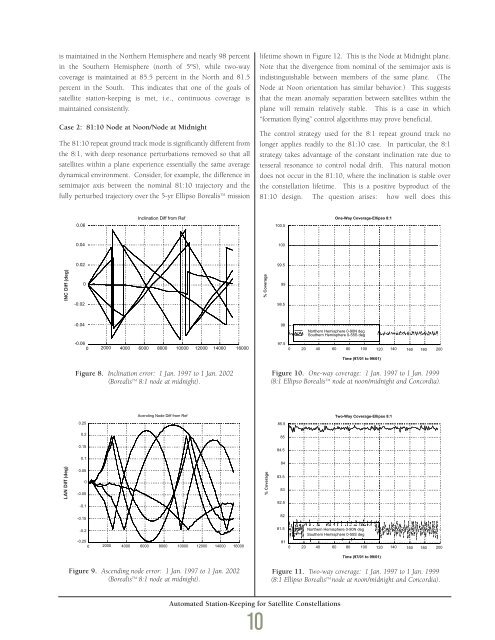1998 - Draper Laboratory
1998 - Draper Laboratory
1998 - Draper Laboratory
- No tags were found...
Create successful ePaper yourself
Turn your PDF publications into a flip-book with our unique Google optimized e-Paper software.
is maintained in the Northern Hemisphere and nearly 98 percentin the Southern Hemisphere (north of 5ºS), while two-waycoverage is maintained at 85.5 percent in the North and 81.5percent in the South. This indicates that one of the goals ofsatellite station-keeping is met, i.e., continuous coverage ismaintained consistently.Case 2: 81:10 Node at Noon/Node at MidnightThe 81:10 repeat ground track mode is significantly different fromthe 8:1, with deep resonance perturbations removed so that allsatellites within a plane experience essentially the same averagedynamical environment. Consider, for example, the difference insemimajor axis between the nominal 81:10 trajectory and thefully perturbed trajectory over the 5-yr Ellipso Borealis TM missionlifetime shown in Figure 12. This is the Node at Midnight plane.Note that the divergence from nominal of the semimajor axis isindistinguishable between members of the same plane. (TheNode at Noon orientation has similar behavior.) This suggeststhat the mean anomaly separation between satellites within theplane will remain relatively stable. This is a case in which“formation flying” control algorithms may prove beneficial.The control strategy used for the 8:1 repeat ground track nolonger applies readily to the 81:10 case. In particular, the 8:1strategy takes advantage of the constant inclination rate due totesseral resonance to control nodal drift. This natural motiondoes not occur in the 81:10, where the inclination is stable overthe constellation lifetime. This is a positive byproduct of the81:10 design. The question arises: how well does this0.06Inclination Diff from Ref100.5One-Way Coverage-Ellipso 8:10.041000.0299.5INC Diff (deg)0-0.02% Coverage9998.5-0.04-0.060 2000 4000 6000 8000 10000 12000 14000 160009897.50Northern Hemisphere 0-90N degSouthern Hemisphere 0-55S deg20 40 60 80 100 120 140 160 180 200Time (97/01 to 99/01)Figure 8. Inclination error: 1 Jan. 1997 to 1 Jan. 2002(Borealis TM 8:1 node at midnight).Figure 10. One-way coverage: 1 Jan. 1997 to 1 Jan. 1999(8:1 Ellipso Borealis TM node at noon/midnight and Concordia).Acending Node Diff from RefTwo-Way Coverage-Ellipso 8:10.2585.50.2850.1584.50.184LAN Diff (deg)0.050-0.05% Coverage83.583-0.182.5-0.1582-0.2-0.250 2000 4000 6000 8000 10000 12000 14000 1600081.5810Northern Hemisphere 0-90N degSouthern Hemisphere 0-55S deg20 40 60 80 100 120 140 160 180 200Time (97/01 to 99/01)Figure 9. Ascending node error: 1 Jan. 1997 to 1 Jan. 2002(Borealis TM 8:1 node at midnight).Figure 11. Two-way coverage: 1 Jan. 1997 to 1 Jan. 1999(8:1 Ellipso Borealis TM node at noon/midnight and Concordia).Automated Station-Keeping for Satellite Constellations10
















